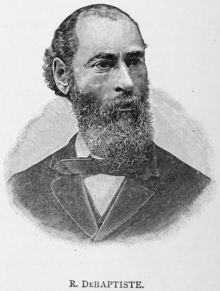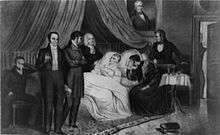George DeBaptiste
| George DeBaptiste | |
|---|---|
| Born |
c1815 Fredericksburg, Virginia, U.S. |
| Died |
February 22, 1875 (aged 59–60) Detroit, Michigan, U.S. |
| Occupation | barber, caterer |
| Known for | Underground Railroad |
| Political party | Republican |
| Religion | Baptist |
George DeBaptiste (c 1815-February 22, 1875) was a prominent conductor on the Underground Railroad in Indiana and Detroit, Michigan. In 1840, he served as valet and then White House steward for US President William Henry Harrison. In the 1830s and 1840s he was an active conductor in Madison, Indiana, on the Ohio River border with Kentucky, a slave state. He moved to Detroit, Michigan in 1846 where he was considered the president of the local underground railroad group. During this period, he purchased a steamboat for carrying fugitives to Canada. It is estimated that DeBaptiste and close collaborator William Lambert secured passage of 30,000 slaves to Canada.[1] In the late 1850s, DeBaptiste worked with Frederick Douglass and John Brown. During the American Civil War, DeBaptiste helped recruit black soldiers, and after the war he continued to work for civil rights.
Early life

George DeBaptiste was born in Fredericksburg, Virginia. Different sources give different parents. One source names John Debaptist and Frances "Franky"; born slaves, but were free by the time of George's birth.[2] Another gives George DeBaptiste and Maria, George owning Maria until he set her free on March 12, 1823.[3] A third source has him as a brother to noted Chicago minister, Richard DeBaptiste and son of a William and Eliza.[4] George learned the barbering trade in Richmond, Virginia. In his mid-teens he married Marie Lucinda Lee, a slave, and purchased her freedom.[2] On January 22, 1835, George obtained a free movement pass for the state of Virginia in the office of Hustings in Richmond, Virginia describing him as, "a mulatto boy, about five feet seven and a half inches high, and about twenty yeas of age, who was born free." He later said he used the certificate 33 times to help slaves escape.[5]
Move to Madison, Indiana
DeBaptiste moved to Madison, Indiana while still young, and around 1836 invested in businesses and harbored black fugitives as a conductor in the Underground Railroad. Madison is on the Ohio River, bordering Kentucky, a slave state, and sits nearly halfway between Cincinnati and Louisville. DeBaptistes ring included Dr. Samuel Tibbers in Madison and William Beard, a Quaker, in Salem, Indiana in Union County. Catherine White Coffin and Levi Coffin were the superintendents of the ring and arranged relays to Canada.[2] In February, 1840, DeBaptiste, Seymour Finney, and William Lambert arranged the noted rescue of Robert Cromwell from a Detroit Courthouse.[2]
Valet to William Henry Harrison

Before his election to US President, William Henry Harrison was living in nearby North Bend, Ohio.[6] DeBaptiste became his valet during his campaign and when Harrison was elected president he became White House steward[7][8] Harrison's term was the shortest ever presidency, as he died of illness after one month in office. DeBaptiste had become very close with the president and was a caretaker of the man during his illness.[6] In an obituary of DeBaptiste, it was written that that at Harrison's death, DeBaptiste was at his side and held the president in his arms at his last breath.[9] After Harrison's death, DeBaptiste returned to Madison[2] where his barbershop became "the nerve center" of the Madison, Indiana underground railroad.[8]
Fugitives along the Ohio River
He was still in Madison in 1843 when he conducted Adam and Sarah Crosswhite and their four children to freedom (he was there again when the Crosswhite's crossed the Detroit River into Canada in 1847).[10] About this time, DeBaptiste, Lambert, and Coffin began working with George J. Reynolds.[6] In 1846, DeBaptiste was still working along the Ohio River, ferrying Kentucky runaways across to Ohio and Indiana and then to Michigan and Ontario. One frequent technique was to loan his own freedom papers to other men of similar height and build. Slavery supporters demanded his arrest for the nonpayment of a $500 bond required be paid by free blacks until Judge Stephen C. Stevens declared that law unconstitutional.[2] DeBaptiste was repeatedly attacked in Madison for his anti-slavery work, and he was forced to leave town.[8]
Move to Detroit, Michigan
At the age 34, in 1846, he moved to Detroit where he continued to work as a barber and also sold clothes at Robert Banks's store. DeBaptiste began to work more closely with his former comrade, William Lambert. They were both members of The Order of Men of Oppression and the Order of Emancipation, groups which fought slavery and raised money to aid fugitives.[2] In Detroit, DeBaptiste was considered to be the "president" of the Detroit Underground Railroad, William Lambert the "vice president" or "secretary" and Laura Haviland the "superintendent".[9] Henry Bibbs was another important figure in the group.[11] George's relative and possibly brother, Richard DeBaptiste, moved to Detroit from Virginia in 1846 and worked with George there, and in the 1850s in Ohio[12]
In 1848, DeBaptiste took work as steward on the steamship, Arrow, which traveled between Sandusky, Ohio and Detroit.[9] Later, DeBaptiste purchased a lake steamship, the T. Whitney. He could not hold a captain's license, so he had to hire a white captain by the name of Atwood. The boat ran a similar route to the Arrow, stopping at Amherstburg, Ontario, Canada to load up on lumber and, presumably, to offload fugitives.[2][9]
DeBaptiste activism extended much further than working as a conductor. He was an occasional correspondent to various anti-slavery journals, including the North Star and the Liberator.[9] He also played a role in the larger national abolitionism movement. On Mach 12, 1859, John Brown, Frederick Douglass, William Lambert, and DeBaptiste met at William Webb's house to discuss emancipation.[1] DeBaptiste proposed that conspirators blow up some of the South's largest churches.[2] The suggestion was opposed by Brown, who felt humanity precluded such unnecessary bloodshed.[11] Before emancipation, DeBaptiste had a $1,000 reward for his head in Kentucky.[11]

Senator James Murray Mason was the head of the investigating committee against Brown. After Brown's insurrection, capture, and hanging, Mason attempted to subpoena a "John DeBaptiste", later changed to "George DeBaptiste" and probably the same George. The Detroit sheriff tasked with serving the warrant wrote to the committee: "Knowing the caste and character of DeBaptiste my first impression on receiving the summons was that if Senator Mason knew the facts he would not desire the summons to be served, even if I should find DeBaptiste here... If DeBaptiste were summoned, there is not probability that he would obey..." and the summons was never served.[9]
Civil war and after
During the American Civil War, DeBaptiste worked with Detroit civil rights activist John D. Richards in recruiting Michigan's first black regiment.[2] He also served as a sutler.[10]
After the war, in the late 1860s, DeBaptiste worked with the Freedmen's Bureau.[2] He also opened a catering business in Detroit[10][13] and even won first prize for his wedding cakes in the 1873 Michigan State Fair.[9] He advocated for the right of black students to attend Detroit Public Schools,[10] and was a member of Second Baptist Church in Detroit.[10] In 1870, he became the first black to be elected delegate to the state Republican nominating convention.[14]
Death
DeBaptiste died February 22, 1875.[9] He was had survived by his second wife, one son, and one daughter[15]
References
- 1 2 Underground Railroad, US Department of Interior, National Park Service, Denver Service Center. DIANE Publishing, Feb 1, 1995, p168
- 1 2 3 4 5 6 7 8 9 10 11 Snodgrass, Mary Ellen. The underground railroad: An encyclopedia of people, places, and operations. Routledge, 2015. p154
- ↑ DeRamus, Betty. Forbidden Fruit: Love Stories from the Underground Railroad. Simon and Schuster, 2005. p11
- ↑ Simmons, William J., and Henry McNeal Turner. Men of Mark: Eminent, Progressive and Rising. GM Rewell & Company, 1887. p352-357
- ↑ Mull, Carol E. The Underground Railroad in Michigan. McFarland, 2015. p60
- 1 2 3 Calarco, Tom. People of the Underground Railroad: A Biographical Dictionary. Greenwood Publishing Group, 2008. p253-255
- ↑ Lause, Mark A. A Secret Society History of the Civil War. University of Illinois Press, 2011. p71
- 1 2 3 Hudson, J. Blaine. Fugitive Slaves and the Underground Railroad in the Kentucky Borderland. McFarland, 2002. p117-118
- 1 2 3 4 5 6 7 8 Tobin, Jacqueline L. From Midnight to Dawn: The Last Tracks of the Underground Railroad. Anchor, 2008. p200-209
- 1 2 3 4 5 Frost, Karolyn Smardz. A Fluid Frontier: Slavery, Resistance, and the Underground Railroad in the Detroit River Borderland. Wayne State University Press, 2016.
- 1 2 3 Toledo, Gregory. The Hanging of Old Brown: A Story of Slaves, Statesmen, and Redemption. Greenwood Publishing Group, 2002. p75
- ↑ Calarco, Tom, and Cynthia Vogel. Places of the Underground Railroad: A Geographical Guide. ABC-CLIO, 2011. p55
- ↑ Advertisement, Detroit Free Press (Detroit, Michigan) July 11, 1872, page 2, accessed October 3, 2016 at https://www.newspapers.com/clip/6877462/advertisement_detroit_free_press/
- ↑ Katz, William Loren. Black Pioneers: An Untold Story. Taylor & Francis, 1999. p123
- ↑ Death of George DeBaptiste, Detroit Free Press (Detroit, Michigan) February 23, 1875, page 1. accessed October 3, 2016 at https://www.newspapers.com/clip/6877579/death_of_george_debaptiste_detroit/